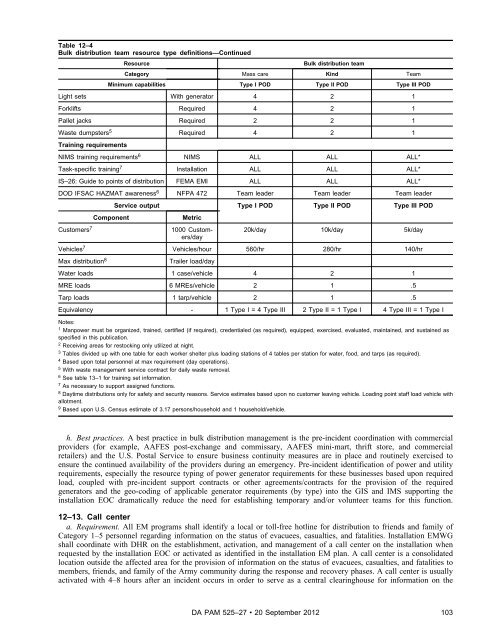Army Emergency Management Program - Federation of American ...
Army Emergency Management Program - Federation of American ...
Army Emergency Management Program - Federation of American ...
You also want an ePaper? Increase the reach of your titles
YUMPU automatically turns print PDFs into web optimized ePapers that Google loves.
Table 12–4<br />
Bulk distribution team resource type definitions—Continued<br />
Resource Bulk distribution team<br />
Category Mass care Kind Team<br />
Minimum capabilities Type I POD Type II POD Type III POD<br />
Light sets With generator 4 2 1<br />
Forklifts Required 4 2 1<br />
Pallet jacks Required 2 2 1<br />
Waste dumpsters 5 Required 4 2 1<br />
Training requirements<br />
NIMS training requirements 6 NIMS ALL ALL ALL*<br />
Task-specific training 7 Installation ALL ALL ALL*<br />
IS–26: Guide to points <strong>of</strong> distribution FEMA EMI ALL ALL ALL*<br />
DOD IFSAC HAZMAT awareness 6 NFPA 472 Team leader Team leader Team leader<br />
Service output Type I POD Type II POD Type III POD<br />
Component Metric<br />
Customers 7 1000 Customers/day<br />
20k/day 10k/day 5k/day<br />
Vehicles 7 Vehicles/hour 560/hr 280/hr 140/hr<br />
Max distribution 8 Trailer load/day<br />
Water loads 1 case/vehicle 4 2 1<br />
MRE loads 6 MREs/vehicle 2 1 .5<br />
Tarp loads 1 tarp/vehicle 2 1 .5<br />
Equivalency - 1 Type I = 4 Type III 2 Type II = 1 Type I 4 Type III = 1 Type I<br />
Notes:<br />
1 Manpower must be organized, trained, certified (if required), credentialed (as required), equipped, exercised, evaluated, maintained, and sustained as<br />
specified in this publication.<br />
2 Receiving areas for restocking only utilized at night.<br />
3 Tables divided up with one table for each worker shelter plus loading stations <strong>of</strong> 4 tables per station for water, food, and tarps (as required).<br />
4 Based upon total personnel at max requirement (day operations).<br />
5 With waste management service contract for daily waste removal.<br />
6 See table 13–1 for training set information.<br />
7 As necessary to support assigned functions.<br />
8 Daytime distributions only for safety and security reasons. Service estimates based upon no customer leaving vehicle. Loading point staff load vehicle with<br />
allotment.<br />
9 Based upon U.S. Census estimate <strong>of</strong> 3.17 persons/household and 1 household/vehicle.<br />
h. Best practices. A best practice in bulk distribution management is the pre-incident coordination with commercial<br />
providers (for example, AAFES post-exchange and commissary, AAFES mini-mart, thrift store, and commercial<br />
retailers) and the U.S. Postal Service to ensure business continuity measures are in place and routinely exercised to<br />
ensure the continued availability <strong>of</strong> the providers during an emergency. Pre-incident identification <strong>of</strong> power and utility<br />
requirements, especially the resource typing <strong>of</strong> power generator requirements for these businesses based upon required<br />
load, coupled with pre-incident support contracts or other agreements/contracts for the provision <strong>of</strong> the required<br />
generators and the geo-coding <strong>of</strong> applicable generator requirements (by type) into the GIS and IMS supporting the<br />
installation EOC dramatically reduce the need for establishing temporary and/or volunteer teams for this function.<br />
12–13. Call center<br />
a. Requirement. All EM programs shall identify a local or toll-free hotline for distribution to friends and family <strong>of</strong><br />
Category 1–5 personnel regarding information on the status <strong>of</strong> evacuees, casualties, and fatalities. Installation EMWG<br />
shall coordinate with DHR on the establishment, activation, and management <strong>of</strong> a call center on the installation when<br />
requested by the installation EOC or activated as identified in the installation EM plan. A call center is a consolidated<br />
location outside the affected area for the provision <strong>of</strong> information on the status <strong>of</strong> evacuees, casualties, and fatalities to<br />
members, friends, and family <strong>of</strong> the <strong>Army</strong> community during the response and recovery phases. A call center is usually<br />
activated with 4–8 hours after an incident occurs in order to serve as a central clearinghouse for information on the<br />
DA PAM 525–27 20 September 2012<br />
103
















